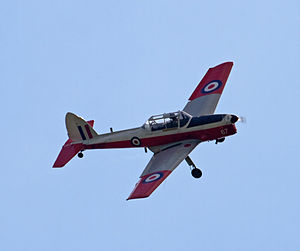De Havilland Canada Chipmunk
| DHC-1 Chipmunk | |
|---|---|
 |
|
| A Chipmunk 1 in 2013 | |
| Role | Trainer |
| Manufacturer | de Havilland Canada |
| Designer | Wsiewołod Jakimiuk |
| First flight | 22 May 1946 |
| Introduction | 1946 |
| Retired | 1972 (Canada) |
| Primary users |
Royal Air Force Royal Canadian Air Force Portuguese Air Force Belgian Air Force |
| Produced | 1947-1956 |
| Number built | 1283 including Canadian, British, and Portuguese production |
The de Havilland Canada DHC-1 Chipmunk is a tandem, two-seat, single-engined primary trainer aircraft which was the standard primary trainer for the Royal Canadian Air Force, Royal Air Force and several other air forces through much of the post-Second World War years. The de Havilland Chipmunk was the first postwar aviation project of de Havilland Canada.
Today, over 500 DHC-1 Chipmunk airframes remain airworthy with more being rebuilt every year.
The Chipmunk was designed to succeed the de Havilland Tiger Moth biplane trainer that was widely used during the Second World War. Wsiewołod Jakimiuk, a Polish prewar engineer, created the first indigenous design of the aircraft at de Havilland Aircraft of Canada Ltd. It is an all-metal, low wing, tandem two-place, single-engined aircraft with a conventional tailwheel landing gear and fabric-covered control surfaces. The wing is also fabric-covered aft of the spar. A clear perspex canopy covers the pilot/student (front) and instructor/passenger (rear) positions. CF-DIO-X, the Chipmunk prototype, flew for the first time at Downsview, Toronto on 22 May 1946 with Pat Fillingham, test pilot from the parent de Havilland company, at the controls. The production version of the Chipmunk was powered by a 145 hp (108 kW) inline de Havilland Gipsy Major 8 engine while the prototype was powered by a 145 hp (108 kW) de Havilland Gipsy Major 1C.
Three Chipmunk aircraft serial numbers 1, 10 and 11, were evaluated by the Aeroplane and Armament Experimental Establishment (A&AEE) at RAF Boscombe Down. As a result, the fully aerobatic Chipmunk was ordered as an ab initio trainer for the Royal Air Force (Prince Philip took his first flying lesson in one in 1952). The Royal Canadian Air Force also adopted the Chipmunk as their primary trainer.
...
Wikipedia
